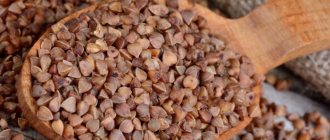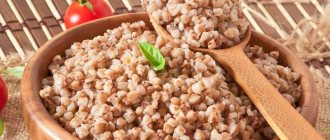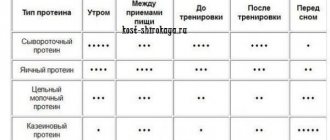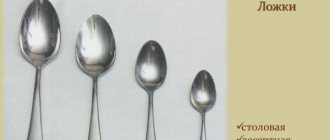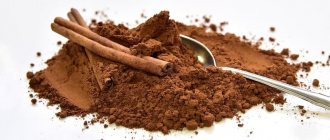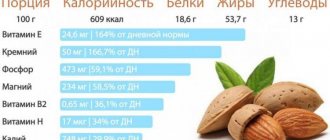It happens that you need to measure a certain weight of buckwheat using spoons. This is required for some recipe, just curious, maybe you need to calculate the calorie content? The reason is not so important, what is more interesting here is how many grams of buckwheat will fit in one spoon.
But buckwheat can also be boiled, maybe someone needs to weigh buckwheat porridge? But spoons are also different; some are interested in tea spoons, while others are interested in table spoons. In general, in this article we will examine in detail all the above questions.
By the way, if you want to cook crumbly buckwheat in water, I recommend following this link. There is a recipe and lots of tips for making delicious porridge.
How many grams of buckwheat in a teaspoon
Measuring cereal with a teaspoon is, of course, unusual, but just in case, below there is information for this case as well.
- About 8 grams of dry buckwheat with a small pile will fit in 1 teaspoon.
- Without a heap, 1 teaspoon will contain approximately 5 grams of “raw” buckwheat.
- 1 teaspoon will hold about 11 boiled buckwheat groats (with a heap)
- 1 teaspoon of boiled buckwheat without a heap is approximately 7 grams.
Table “How many grams of buckwheat in a spoon”
| Spoon type | Weight of raw (dry) buckwheat | Weight of boiled buckwheat |
| 1 tea without slide | 18 grams | 25 |
| 1 tea room with a slide | 25 grams | 30 g. |
| 1 dining room without slide | 5 grams | 7 years |
| 1 dining room with slide | 8 grams | 11 |
How to measure buckwheat with a tablespoon
- 30 grams of buckwheat - how many spoons? 30 g of buckwheat is 1 tablespoon of buckwheat (without a slide) plus 2 teaspoons of buckwheat (with a slide)
- 40 grams of buckwheat - how many spoons? 40 g of buckwheat is 2 tablespoons of buckwheat (with a small slide)
- 50 grams of buckwheat - how many spoons? 50 g of buckwheat is 2 tablespoons of dry buckwheat (heaped)
- 60 grams of buckwheat - how many spoons? 60 g of buckwheat is 3 tablespoons of buckwheat (with a small slide)
- 75 grams of buckwheat - how many spoons? 75 g of buckwheat is 3 tablespoons of buckwheat (heaped)
- How many spoons are 100 grams of buckwheat 100 g of buckwheat is 4 tablespoons of buckwheat (heaped)
- 150 grams of buckwheat - how many spoons? 150 g of buckwheat is 6 tablespoons of buckwheat (heaped)
- 200 grams of buckwheat - how many spoons? 200 g of buckwheat is 8 tablespoons of buckwheat (heaped)
- 250 grams of buckwheat - how many spoons? 250 g of buckwheat is 10 tablespoons of buckwheat (heaped)
- 300 grams of buckwheat - how many spoons? 300 g of buckwheat is 12 tablespoons of buckwheat (heaped)
- 100 grams of boiled buckwheat - how many tablespoons? 100 g of boiled buckwheat is 4 tablespoons of boiled buckwheat (without a slide)
How to measure the required weight of buckwheat with a spoon (measuring table)
Below are grams of buckwheat, most often used in various culinary recipes. Here we mean dry (raw) buckwheat. We will measure with a tablespoon.
| Buckwheat weight in grams | How many spoons |
| 500 grams | 20 tbsp. heaped spoon |
| 450 grams | 18th century heaped spoon |
| 400 grams | 16th century spoon with a heap |
| 350 grams | 14th century spoon with a heap |
| 300 grams | 12 tbsp. spoon with a heap |
| 250 grams | 10 tbsp. spoon with a heap |
| 200 grams | 8 tbsp. heaped spoon |
| 150 grams | 6 tbsp. heaped spoon |
| 100g | 4 tbsp. heaped spoons |
| 90 grams | 3 heaped tablespoons |
| 50 grams | 2 tbsp. spoons with heaps |
| 30 grams | 1 tbsp. heaped spoon |
| 20 grams | 4 level spoons |
| 10 grams | 2 level spoons |
Table for measuring the weight of buckwheat with a tablespoon
| Weight in grams | Number of spoons |
| 10 grams of buckwheat is | 2 level teaspoons |
| 20 grams of buckwheat is | 4 level teaspoons |
| 30 grams of buckwheat is | 1 level tablespoon 2 heaped teaspoons |
| 40 grams of buckwheat is | 2 heaping tablespoons |
| 50 grams of buckwheat is | 2 heaped tablespoons |
| 60 grams of buckwheat is | 3 heaping tablespoons |
| 70 grams of buckwheat is | 3 heaped tablespoons 2 level teaspoons |
| 75 grams of buckwheat is | 3 heaped tablespoons |
| 80 grams of buckwheat is | 3 heaped tablespoons 1 level teaspoon |
| 90 grams of buckwheat is | 3 heaped tablespoons 3 level teaspoons |
| 100 grams of buckwheat is | 4 heaped tablespoons |
| 150 grams of buckwheat is | 6 heaped tablespoons |
| 200 grams of buckwheat is | 8 heaped tablespoons |
| 250 grams of buckwheat is | 10 heaped tablespoons |
| 300 grams of buckwheat is | 12 heaped tablespoons |
| 350 grams of buckwheat is | 14 heaped tablespoons |
| 400 grams of buckwheat is | 16 heaped tablespoons |
| 450 grams of buckwheat is | 18 heaped tablespoons |
| 500 grams of buckwheat is | 20 heaped tablespoons |
Buckwheat is very popular in our climate. This cereal is loved for its original taste, which cannot be replaced with anything. The cereal is very healthy; buckwheat contains a lot of vitamins and minerals. Which give a person strength, vigor and endurance. What gives buckwheat its zest is that buckwheat is a pure ecological product. Because the buckwheat plant does not require fertilizers and grows in natural conditions. Due to this, buckwheat does not contain toxins and harmful chemicals. It’s not for nothing that this cereal is nicknamed “Royal Cereal.”
How many calories are in a spoonful of buckwheat?
Watch your figure, follow some kind of strict diet, constantly counting your daily calorie intake? In this case, you may be interested in the calorie content of one spoon of buckwheat, so that you ultimately consume as many calories as planned.
- To calculate, you first need to find out how many calories are in 100 grams of product.
- The calorie content of dry buckwheat per 100 grams is 308 kcal.
- The calorie content of boiled buckwheat per 100 grams is 92 kcal.
- It follows that 1 tablespoon of dry buckwheat contains 77 kcal. And 1 tablespoon of boiled buckwheat porridge is 27.6 kcal.
If you found this material useful, share the link on social networks. By the way, this site has many other useful articles: tips, various recipes, etc. We advise you to read it.
Buckwheat combines two paradoxical qualities. An unusually satisfying and nutritious product - at the same time, truly low-calorie and perfect even for very strict diets. The reason for this is the high content of proteins and complex carbohydrates, which makes buckwheat dishes extremely healthy for people who lead an active lifestyle and play sports.
Calorie content of boiled and raw buckwheat
We suggest that you familiarize yourself with two comparative tables of calorie content of buckwheat. The first table contains data on the calorie content of buckwheat porridge boiled in water without additives
, and the second is about the nutritional value
of raw cereals
.
100 grams of boiled buckwheat contains*:
| % of daily value | ||
| Calories: | 110 kcal | 4.4% |
| Proteins: | 4.2 g | 5.6% |
| Carbohydrates: | 21.3 g | 5.8% |
| of which sugar: | 0 g | 0.0% |
| Fats: | 1.1 g | 1.3% |
| of which saturated: | 0 g | 0.0% |
| Cellulose: | 0.3 g | 1.2% |
The nutritional value of 50 grams of boiled buckwheat is 55 kcal. Proteins: 2.1 g, carbohydrates: 10.65 g, Fats: 0.55 g.
100 grams of raw buckwheat contains:
| % of daily value | ||
| Calories: | 330 kcal | 13.2% |
| Proteins: | 12.6 g | 16.80% |
| Carbohydrates: | 64 g | 17.53% |
| of which sugar: | 0 g | 0.00% |
| Fats: | 3.3 g | 3.98% |
| of which saturated: | 0 g | 0.00% |
| Cellulose (fiber): | 1.1 g | 3.67% |
* The calorie content of boiled buckwheat and the BZHU ratio
depend on the method of its preparation and the amount of water. The table shows approximate figures. The nutritional value of 100 grams of ready-made porridge, prepared with water and without adding oil, usually does not exceed 110 kcal.
Thus, 100 grams of raw buckwheat (this is exactly how much is usually needed to prepare one or two servings of porridge) contains only 330 kilocalories, which is only 13.2% of the daily requirement of an adult (2500 kcal).
All the beneficial properties of buckwheat
Buckwheat porridge and other buckwheat dishes are good for our health and well-being due to their balanced composition and high nutritional value. At the same time, you should not think that the nutritional value of buckwheat porridge is a consequence of its high calorie content. Not at all - the secret of nutrition lies in the large amount of “slow” carbohydrates and complete, easily digestible proteins in its composition.
In no case should you be afraid of a relatively large amount of carbohydrates
in raw cereals.
As we mentioned above, buckwheat does not contain fast carbohydrates at all, which lead to sharp fluctuations in blood sugar levels. All carbohydrates contained in buckwheat are slow, which means that one serving of buckwheat porridge will create a long-term feeling of fullness, despite its low energy value. Thanks to this, buckwheat porridge is excellent for weight loss
and can be included in a healthy breakfast, which will help avoid feeling hungry until lunch.
The most valuable nutritional components of buckwheat for people actively involved in sports, and, first of all, weightlifting, are proteins.
.
Here they contain as much as 12.6 grams per serving. At the same time, the amino acid composition of proteins is one of the richest and most balanced among plant foods. Buckwheat proteins contain a large amount of important amino acids - lysine and methionine. At the same time, buckwheat proteins are highly digestible, which makes this grain indispensable in the diet of athletes to speed up muscle recovery after training. Buckwheat does not contain a single gram of fast carbohydrates, which are responsible for the appearance of excess weight if consumed in excess.
Very often, buckwheat is used as a temporary substitute for meat and other sources of animal proteins. For the same reason, this cereal is consistently popular among vegetarians
, for which its rich amino acid profile is especially important.
Regarding fats
, then there are very few of them in buckwheat - only 3.3 grams per serving.
At the same time, there are no harmful saturated fats at all. However, it’s not for nothing that the proverb says that “You can’t spoil porridge with butter.” For better absorption and a more pleasant taste of buckwheat porridge, it is better to add a small amount of vegetable oil to it (linseed oil will be especially useful due to the high amount of OMEGA-3 and will perfectly complement the taste) or initially prepare it with milk rather than water. You can fry a portion of porridge with two eggs a little more, so it will become even more tasty and crumbly
.
Mineral composition and vitamins
Now that we have found out how many calories are in dry and boiled buckwheat, let’s move on to the mineral composition and vitamins contained in it.
| Name | Quantity | % of daily value |
| Vitamin B1: | 0.51 mg | 34.00% |
| Vitamin B2: | 0.24 mg | 13.33% |
| Vitamin PP: | 4.3 mg | 21.50% |
| Calcium: | 30 mg | 2.0% |
| Iron: | 6.7 mg | 47.66% |
| Vitamin A / Vitamin C: | 0 mg | 0.00% |
Buckwheat contains important water-soluble B vitamins, which, unlike fat-soluble vitamins, must be supplied to our body daily, because do not accumulate in it. In terms of minerals, buckwheat is certainly one of the leaders in iron content. However, we must remember that the iron we get from plant products is absorbed much worse than from animal products. If you are a vegetarian, you should consider taking additional vitamin and mineral supplements with iron.
In general, buckwheat cannot be called rich in minerals and vitamins. For this reason, we do not recommend “sitting” on the popular “buckwheat diet” for a long time, because Despite all its beneficial properties and nutritional value, a lack of vitamins can lead to vitamin deficiency and many other unpleasant consequences. As they say, everything is good in moderation.
And only as part of a varied diet, buckwheat exhibits all its beneficial properties. Buckwheat porridge is an excellent and balanced dietary product that can be safely recommended for regular consumption by absolutely everyone - children, women and bodybuilders who want to lose weight and maintain body weight (it is especially useful to eat buckwheat a few hours before strength training, because it gives a long feeling of fullness) both to athletes and, of course, to older people.
Calories and nutritional value
Buckwheat porridge is ideal for athletes and people watching their figure. Despite its nutritional value, it does not contribute to weight gain. It is a valuable source of vitamins and minerals.
Per 100 grams of dry grain there are 305 kcal with the following distribution of BJU: proteins - 14 g, fats - 4 g, carbohydrates - 60 g.
However, such a high indicator does not interfere with weight loss, since in the finished state the cereal is lower in calories. It’s easy to calculate how many calories are in one serving of buckwheat porridge yourself:
- Take the ratio of kernels and water 1:2 (for example, 100 g per 200 ml).
- After cooking, it swells, resulting in 300 g, while the total calorie content remains unchanged - 305 kcal.
- Divide this value by 3, so the energy value of 100 g is no more than 102 kcal.
The composition contains a predominance of carbohydrates, but they are complex and have a low glycemic index. Therefore, they are not forbidden to use without restrictions. That is why the product is indicated for mono-diets and fasting days.
Calorie content and nutritional value of all types of buckwheat per 100 g serving:
| Cooking method | Number of calories, kcal | Proteins, g | Fats, g | Carbohydrates, g |
| Boiled in water without salt and oil | 100,8 | 4,2 | 1,1 | 18,5 |
| On water, with oil | 137, 4 | 3,5 | 5,7 | 16,8 |
| With salt and butter | 142 | 4 | 2,6 | 16,6 |
| With salt and sunflower oil | 153,7 | 4,8 | 5,2 | 27,4 |
| With milk, no sugar or butter | 117,5 | 6,5 | 4,3 | 17,5 |
| With milk and sugar | 176 | 3,8 | 1,7 | 28,1 |
| With milk and butter | 177 | 6,2 | 7,1 | 21,8 |
| With meat (chicken, beef, turkey) | 117/108,6/105 | 10/6,7/9 | 2,4/4,4/2,8 | 13,8/11,3/11,5 |
| With kefir | 75,6 | 5,3 | 0,8 | 16,2 |
| Steamed | 108,2 | 4 | 1,5 | 20,8 |
How much buckwheat is in 1 glass?
Now we have to figure out how many glasses 100 grams of buckwheat are. When understanding this issue, it is worth paying attention to the fact that there are two types of glasses: tea glasses and faceted glasses. Both are characterized by a volume of 250 ml, provided that the container is filled to the top.
The main difference between a faceted glass is a narrow strip located in the upper part, popularly called a rim or a belt. The volume of such a vessel along this very rim is 200 ml. It is important to know about this, since a cut glass is used in cooking more often than a tea glass.
Both glasses will contain 200 grams of cereal. This is provided that the container is filled to the top. Therefore, when figuring out how much 100 grams of buckwheat is, remember that in a glass half-filled there is exactly 100 grams of it.
